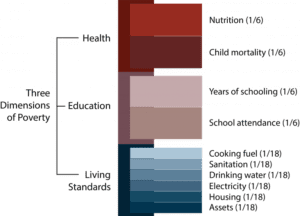Multi-Dimensional Poverty Index
#GS-02 Social Justice
For Prelims
About Multidimensional Poverty Index (MPI):
- Multidimensional Poverty Index (MPI) is an annual report produced by the United Nations Development Programme (UNDP) and the Oxford Poverty and Human Development Initiative (OPHI).
- It replaced the Human Poverty Index.
- The MPI is published along with the HDI (Human Development Index) in the Human Development Report.

Global MPI – Dimensions, Indicators, Deprivation Cutoffs, and Weights
| DIMENSIONS OF POVERTY |
INDICATOR | DEPRIVED IF LIVING IN A HOUSEHOLD WHERE… | WEIGHT |
| Health (1/3) |
Nutrition | Any person under 70 years of age for whom there is nutritional information is undernourished. | 1/6 |
| Child mortality | A child under 18 has died in the household in the five-year period preceding the survey. | 1/6 | |
| Education (1/3) | Years of schooling | No eligible household member has completed six years of schooling. | 1/6 |
| School attendance | Any school-aged child is not attending school up to the age at which he/she would complete class 8. | 1/6 | |
| Living Standards (1/3) | Cooking fuel | A household cooks using solid fuel, such as dung, agricultural crop, shrubs, wood, charcoal, or coal. | 1/18 |
| Sanitation | The household has unimproved or no sanitation facility or it is improved but shared with other households. | 1/18 | |
| Drinking water | The household’s source of drinking water is not safe or safe drinking water is a 30-minute or longer walk from home, roundtrip. | 1/18 | |
| Electricity | The household has no electricity. | 1/18 | |
| Housing | The household has inadequate housing materials in any of the three components: floor, roof, or walls. | 1/18 | |
| Assets | The household does not own more than one of these assets: radio, TV, telephone, computer, animal cart, bicycle, motorbike, or refrigerator, and does not own a car or truck. | 1/18 |
For Mains
What did the MPI report say about India?
- About 41.5 crore people exited poverty in India during the 15-year period between 2005-06 and 2019-21, out of which two-third exited in the first 10 years, and one-third in the next five years.
- Incidence of poverty fell from 55.1% in 2005-06 to 16.4% in 2019-21 in the country and that deprivations in all 10 MPI indicators saw significant reductions as a result of which the MPI value and incidence of poverty more than halved.
- Bihar, the poorest State in 2015-2016, saw the fastest reduction in MPI value in absolute terms.
- The incidence of poverty there fell from 77.4% in 2005-2006 to to 34.7% in 2019-2021.
- India has the largest number of poor people worldwide at 22.8 crore, followed by Nigeria at 9.6 crore.
- There were also 9.7 crore poor children in India in 2019-2021 — more than the total number of poor people, children and adults combined, in any other country covered by the global MPI.
- South Asia for the first time is not the region with the highest number of poor people, at 38.5 crore, compared with 57.9 crore in Sub-Saharan Africa.




